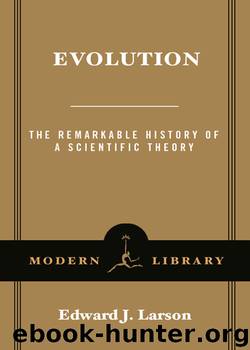Evolution by Edward J. Larson

Author:Edward J. Larson
Language: eng
Format: epub
ISBN: 9781588365385
Publisher: Random House Publishing Group
Published: 2006-08-08T04:00:00+00:00
Thomas Hunt Morgan’s 1915 diagram of the Mendelian genetics of eye color in fruit flies, with the mother’s egg containing an X chromosome carrying a gene for red eyes and the father’s sperm containing either an X chromosome carrying a mutant gene for white eyes or a Y chromosome with no gene for eye color.
Once Morgan and his students had mastered the enterprise, discoveries and insights poured out of the fly room. Between 1911 and 1915, they identified dozens of mutations. Through breeding experiments, they determined that all the mutant traits fell into one of four linkage groups corresponding to the number of chromosome pairs in fruit-fly cells. The genes for each linked trait typically reside on the same chromosome pair, Morgan concluded, although not always. Eye color normally linked with sex, for example, but exceptions occurred, such as in the rare cases of white-eyed females. Experience showed that some links were stronger (or exhibited fewer exceptions) while other links were weaker (or exhibited more exceptions).
To account for these experimental results, Morgan turned to the work of Belgian cytologist Franz Janssens. In 1909, Janssens observed that, during the process of meiosis, chromosomes occasionally cross over each other, break apart at corresponding points, and reconnect with an exchange of parts. Such recombinations would disrupt gene linkages, Morgan reasoned, and the farther apart two genes lay on a chromosome, the more likely that a break could occur between them. Variations in the strength of different gene linkages suggested to Morgan that genes must lie along the length of chromosomes, like beads on strings that occasionally break during meiosis. Sturtevant noted that this phenomenon, coupled with data on the relative strengths of various gene linkages, should allow researchers to map the location of specific genes on various chromosomes. Without ever seeing a gene, by 1915 Morgan and his students had used their study of mutant flies to establish the existence of genes, map their locations on chromosomes, and elucidate the basic elements of classical genetics.
The Mechanism of Mendelian Inheritance effectively completed a revolution in scientific thought that placed genes at the center of biologists’ conception of heredity, pushing environmental and developmental factors to the periphery (just as Francis Galton had wanted). In time, these tiny material particles would become the foundation blocks for a new synthesis in evolutionary thought.
Morgan never fully passed over from the wilderness of mutation theory to the promised land in which classical genetics and selection theory combine to form the modern neo-Darwinian synthesis. An avowed empiricist, Morgan only trusted theories he could confirm by laboratory experiment—and natural selection proved difficult to test in that way, especially with fruit flies maintained in artificial conditions conducive to their survival. Experiments showed him that mutations were smaller than he had originally thought, and that they were preserved and propagated in a Mendelian manner, but his basic view did not change. He payed little attention to other sources of genetic variation, such as gene flows across species. New types of organisms evolve over
Download
This site does not store any files on its server. We only index and link to content provided by other sites. Please contact the content providers to delete copyright contents if any and email us, we'll remove relevant links or contents immediately.
Sapiens: A Brief History of Humankind by Yuval Noah Harari(13100)
Sapiens by Yuval Noah Harari(4567)
Homo Deus: A Brief History of Tomorrow by Yuval Noah Harari(4301)
Pale Blue Dot by Carl Sagan(4027)
Origin Story: A Big History of Everything by David Christian(3150)
Livewired by David Eagleman(3146)
Brief Answers to the Big Questions by Stephen Hawking(2886)
Inferior by Angela Saini(2844)
Origin Story by David Christian(2698)
The Evolution of Beauty by Richard O. Prum(2557)
Signature in the Cell: DNA and the Evidence for Intelligent Design by Stephen C. Meyer(2509)
The Gene: An Intimate History by Siddhartha Mukherjee(2506)
Aliens by Jim Al-Khalili(2392)
How The Mind Works by Steven Pinker(2231)
Sex at Dawn: The Prehistoric Origins of Modern Sexuality by Ryan Christopher(2154)
From Bacteria to Bach and Back by Daniel C. Dennett(2153)
A Short History of Nearly Everything by Bryson Bill(2145)
Endless Forms Most Beautiful by Sean B. Carroll(2092)
Who We Are and How We Got Here by David Reich(2067)
